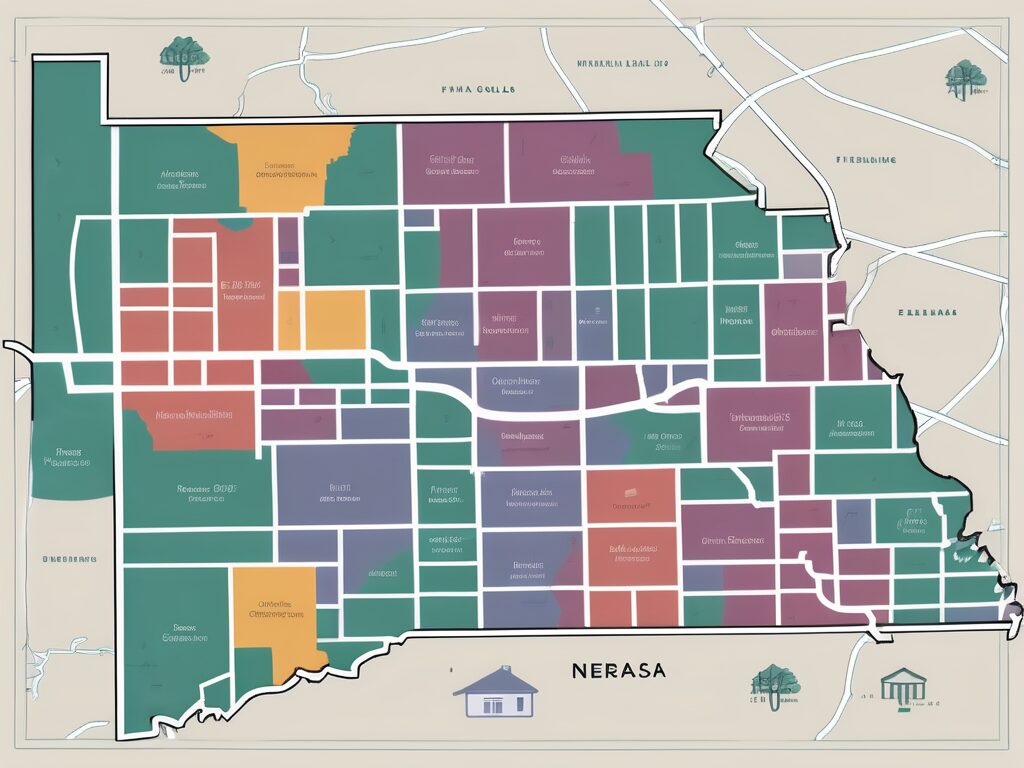
Agent A-Team or Solo Superhero? Finding the Right Real Estate Partner for Your Selling Journey in Wildwood Florida
When it comes to selling your home in Wildwood, Florida,…
January 29, 2024
If you’re considering buying a home in Nebraska, you may have come across the term “FHA loan limits.” These limits play a crucial role in determining the maximum amount of money you can borrow through the Federal Housing Administration (FHA) loan program. Understanding these limits is essential for homebuyers looking to make the most informed decisions about their financing options. In this comprehensive guide, we will explore everything you need to know about FHA loan limits in Nebraska.
Before diving into the details, it’s important to have a clear understanding of what FHA loan limits are and how they work. In simple terms, FHA loan limits refer to the maximum loan amounts that the FHA will insure for different types of properties in specific geographic areas.
When it comes to FHA loan limits in Nebraska, they can vary from county to county. This means that the maximum loan amount you can qualify for may depend on where the property is located. To get a better idea of the specific loan limits in your desired county, it is essential to consult the official FHA website or contact a local FHA-approved lender.
Nebraska, known for its vast plains and rich agricultural heritage, offers a diverse range of housing options across its counties. From the bustling city life of Douglas County, home to Omaha, to the serene landscapes of Cherry County, each county has its own unique charm and character.
Understanding the FHA loan limits by county is crucial when considering buying a home in Nebraska. Let’s take a closer look at some of the counties and their respective loan limits:
Located in eastern Nebraska, Douglas County is the most populous county in the state. With its vibrant cityscape, cultural attractions, and thriving economy, it’s no wonder that many individuals and families aspire to call this county home. The FHA loan limit for a single-family home in Douglas County is $356,362, allowing prospective buyers to explore a wide range of housing options within the county.
Home to the state capital, Lincoln, Lancaster County offers a blend of urban amenities and natural beauty. The FHA loan limit for a single-family home in Lancaster County is $356,362, mirroring that of Douglas County. This provides potential homebuyers with ample opportunities to find their dream home in this vibrant county.
Located just south of Douglas County, Sarpy County is known for its excellent schools, family-friendly communities, and proximity to Omaha. The FHA loan limit for a single-family home in Sarpy County is $356,362, aligning with the loan limits of Douglas and Lancaster Counties. This opens up possibilities for individuals and families looking to settle down in this thriving county.
These are just a few examples of the FHA loan limits in Nebraska. It’s important to note that loan limits may vary in other counties across the state. To explore the specific loan limits in your desired county, it is recommended to consult the official FHA website or reach out to a local FHA-approved lender.
Understanding the FHA loan limits in Nebraska is essential for anyone considering purchasing a home in the state. By familiarizing yourself with these limits, you can make informed decisions and navigate the homebuying process with confidence.
Now that we understand the basics of FHA loan limits, let’s delve into the factors that influence them. While the FHA ultimately sets the loan limits, they primarily rely on two key factors:
One crucial factor in determining FHA loan limits is the median home price in the area. The FHA takes into account the local housing market’s health and affordability when establishing these limits. As median home prices fluctuate, so do the loan limits. By doing so, the FHA aims to ensure that loans remain accessible to a wide range of homebuyers, regardless of market conditions.
When setting FHA loan limits, the median home price acts as a benchmark for determining the maximum loan amount that can be insured by the FHA. If the median home price in a particular area is high, the FHA loan limit for that area will also be higher. This allows borrowers in more expensive housing markets to still have access to FHA loans, which often have more flexible qualification requirements compared to conventional loans.
Conversely, if the median home price in an area is low, the FHA loan limit for that area will also be lower. This ensures that the loan limits are aligned with the local market conditions and prevent excessive borrowing in areas with lower home prices. By adjusting the loan limits based on median home prices, the FHA aims to strike a balance between providing access to affordable housing and managing risk.
It’s important to note that the FHA updates the loan limits annually to reflect changes in median home prices. This ensures that the loan limits remain current and responsive to market fluctuations. By regularly reviewing and adjusting the loan limits, the FHA can adapt to changes in the housing market and maintain its mission of promoting homeownership opportunities for all Americans.
Another factor that influences FHA loan limits is the loan-to-value (LTV) ratio. The LTV ratio is the percentage of the property’s appraised value that the borrower is seeking to finance with an FHA loan. The higher the LTV ratio, the riskier the loan is considered by the FHA.
The FHA sets different loan limits based on the LTV ratio to manage risk and ensure the financial stability of the program. For example, the loan limit for a property with an LTV ratio of 90% may be lower than the limit for a property with an LTV ratio of 80%. This is because a higher LTV ratio indicates a higher loan amount relative to the property’s value, which increases the risk of default.
By adjusting the loan limits based on the LTV ratio, the FHA aims to strike a balance between providing access to financing and managing risk. This approach helps protect the FHA’s insurance fund and ensures the long-term sustainability of the program.
It’s worth noting that the FHA provides flexibility in determining the LTV ratio for certain borrowers, such as those with lower credit scores or limited down payment funds. In these cases, the FHA may allow a higher LTV ratio, but the loan limit will still be subject to the FHA’s guidelines and restrictions.
In conclusion, the factors that influence FHA loan limits include the median home prices in the area and the loan-to-value ratio. These factors help the FHA establish loan limits that align with local market conditions, promote homeownership opportunities, and manage risk. By considering these factors, the FHA aims to ensure that FHA loans remain accessible and sustainable for borrowers across different housing markets.
If you’re interested in obtaining an FHA loan in Nebraska, it’s essential to familiarize yourself with the qualification process. Meeting the necessary requirements is crucial to secure this type of financing. Let’s take a closer look at what it takes to qualify for an FHA loan in Nebraska.
Nebraska, known as the Cornhusker State, offers a variety of housing options for its residents. Whether you’re a first-time homebuyer or looking to upgrade to a larger property, an FHA loan can be a viable option. With its lenient eligibility criteria and low down payment requirements, this type of loan can make homeownership more accessible for many Nebraskans.
Before applying for an FHA loan, there are specific requirements you must meet. These include:
Meeting these requirements is essential if you want to pursue an FHA loan in Nebraska. It’s also worth noting that the FHA sets the requirements as a minimum, and individual lenders may have additional criteria that you must fulfill.
When it comes to credit scores, having a score of 580 or higher is considered favorable for FHA loan eligibility. However, even if your credit score falls below this threshold, you may still be able to qualify for an FHA loan with a higher down payment and a more detailed review of your financial history.
Additionally, demonstrating a steady employment history is crucial for FHA loan approval. Lenders want to ensure that borrowers have a reliable source of income to make their mortgage payments consistently. Having a stable job and a consistent work history can strengthen your application and increase your chances of qualifying for an FHA loan.
Maintaining a healthy debt-to-income ratio is another critical factor in the qualification process. Lenders want to see that your monthly debt obligations, such as credit card payments, student loans, and car loans, are manageable in relation to your income. Keeping your debt-to-income ratio within the acceptable range demonstrates your ability to handle the financial responsibilities of homeownership.
Lastly, providing proof of reliable income and sufficient funds for the down payment and closing costs is a requirement for FHA loan approval. Lenders will review your income documents, such as pay stubs and tax returns, to ensure that you have a stable income stream. Additionally, you’ll need to show that you have enough money saved for the down payment and closing costs, which typically range from 3.5% to 5% of the purchase price.
One advantageous aspect of FHA loans is their flexibility when it comes to multifamily properties. With an FHA loan, you have the option to finance the purchase of a property with up to four units. This can provide significant benefits for homebuyers looking to generate additional income through rental units. Owning a multifamily property can also be an excellent way to build wealth through real estate investments.
Imagine the possibilities of owning a multifamily property in Nebraska. You could live in one unit while renting out the others, effectively having your tenants help pay your mortgage. This arrangement not only reduces your monthly housing expenses but also provides you with a steady stream of rental income. It’s a win-win situation that can contribute to your financial stability and long-term wealth-building goals.
Furthermore, investing in real estate through multifamily properties can offer various tax benefits. You may be eligible to deduct expenses such as mortgage interest, property taxes, insurance premiums, and maintenance costs. These deductions can help lower your overall tax liability and increase your cash flow from the rental units.
Nebraska’s real estate market offers a range of multifamily properties, from duplexes to fourplexes, in both urban and suburban areas. Whether you’re looking for a property in Omaha, Lincoln, or any other city in the state, an FHA loan can be a valuable tool to finance your investment and start your journey as a real estate investor.
In conclusion, navigating the qualification process for an FHA loan in Nebraska requires meeting specific requirements set by the FHA and individual lenders. By understanding these requirements and exploring the benefits of buying a multifamily property, you can make informed decisions and take advantage of the opportunities available to you. Remember to consult with a knowledgeable mortgage professional to guide you through the process and ensure a smooth path to homeownership.
Now that we have covered the fundamentals of FHA loan limits and the qualification process, it’s crucial to find reliable FHA lenders who can assist you throughout the financing journey. Here are some of the top FHA lenders in Nebraska:
When selecting an FHA lender, it’s crucial to compare their offerings, interest rates, and customer reviews to find the one that aligns with your requirements.
But let’s delve deeper into the world of FHA lenders in Nebraska. Lender 1, for example, not only offers competitive interest rates, but they also have a team of experienced loan officers who are well-versed in the intricacies of FHA financing. These loan officers can provide personalized assistance to help you navigate the loan application process seamlessly. Whether you’re a first-time homebuyer or looking to refinance, Lender 1 can guide you every step of the way.
Now, let’s turn our attention to Lender 2. With their expertise in FHA financing, they understand the unique needs of homebuyers in Nebraska. Their dedicated team of loan officers has a deep understanding of the local market and can provide valuable insights to help you make informed decisions. From pre-qualification to closing, Lender 2 ensures a smooth and efficient experience for their clients.
Lastly, let’s explore Lender 3. Committed to providing accessible financing options, Lender 3 understands that every homebuyer’s situation is unique. Their knowledgeable staff takes the time to understand your specific needs and goals, and then helps you explore FHA loan programs tailored to your requirements. With Lender 3, you can rest assured that you’ll find the right solution for your homeownership journey in Nebraska.
In conclusion, understanding FHA loan limits is vital for homebuyers in Nebraska. By comprehending these limits and the factors that influence them, you can navigate the qualification process with confidence. Additionally, finding reliable FHA lenders who specialize in Nebraska financing can ensure a seamless experience from application to closing. Armed with this knowledge, you are ready to embark on your homeownership journey in Nebraska.
As you embark on your journey to homeownership in Nebraska with the insights on FHA loan limits, don’t forget the importance of a proper home valuation. Richr is here to assist you with a complimentary home valuation to ensure you’re making informed decisions. Whether you’re considering selling your home FSBO or simply need an accurate market analysis, Richr’s platform connects you to consumer portals and MLS listings for maximum exposure. Ready to unlock your home’s true value? Call Richr on 844-957-4247 for your free CMA today.

If you want the Richr team to help you save thousands on your home just book a call.
 Book a call
Book a call